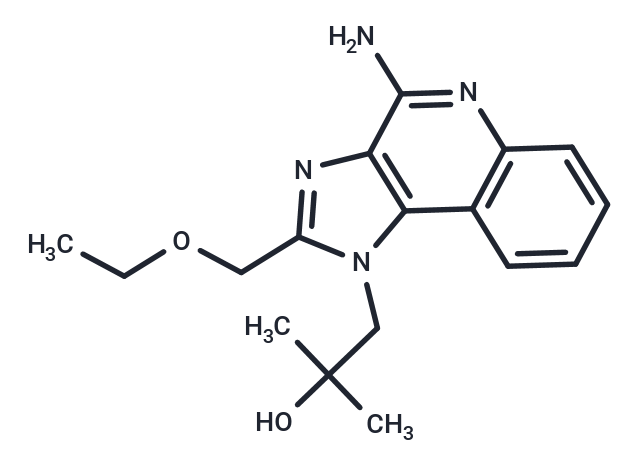Shopping Cart
- Remove All
 Your shopping cart is currently empty
Your shopping cart is currently empty

Resiquimod (R848) is a Toll-like receptor 7/8 (TLR7/TLR8) agonist that induces cytokine upregulation. Resiquimod is an immunomodulator with antitumor and antiviral activity.

| Pack Size | Price | Availability | Quantity |
|---|---|---|---|
| 5 mg | $30 | In Stock | |
| 10 mg | $47 | In Stock | |
| 25 mg | $79 | In Stock | |
| 50 mg | $139 | In Stock | |
| 100 mg | $197 | In Stock | |
| 200 mg | $263 | In Stock | |
| 500 mg | $389 | In Stock | |
| 1 mL x 10 mM (in DMSO) | $43 | In Stock |
| Description | Resiquimod (R848) is a Toll-like receptor 7/8 (TLR7/TLR8) agonist that induces cytokine upregulation. Resiquimod is an immunomodulator with antitumor and antiviral activity. |
| In vitro | METHODS: Golden pompholyte kidney lymphocytes HKL were treated with Resiquimod (0.175-32 µg/mL) for 12 h. Cell viability was measured by CCK8 assay. RESULTS: CCK8 assay showed that 0.25-32 µg/mL Resiquimod significantly promoted HKL proliferation. [1] METHODS: Peripheral blood mononuclear cells PBM were treated with Resiquimod (0.01-100 µM) for 1-14 h, and the expression levels of target proteins were detected by Western Blot. RESULTS: A dose of 1 µM was sufficient to alter the expression of FcγR, and higher doses did not result in greater changes. the increase in FcγRIIa occurred at a late stage, while a small increase in the γ chain was seen at 3 h, but was higher at 14 h. However, the FcγRIIb protein decreases at 1 h, while the FcγRIIb transcript is maintained until 4 h.[2] |
| In vivo | METHODS: To detect anti-tumor activity in vivo, Resiquimod (2 mg/kg) and 4D5 anti-HER2 antibody (20 mg/kg) were injected intraperitoneally three times per week for 13 days into Balb/cJ mice bearing CT26-HER2/neu tumors. RESULTS: After 13 days, the tumor growth rate of mice receiving Resiquimod plus antibody was significantly reduced. Statistical tests showed a synergistic effect of 4D5 and Resiquimod in reducing tumor growth rate. [2] |
| Kinase Assay | For luciferase assay, FG-9307 cells are transfected with the firefly NF-κB-specific luciferase reporter vector pNFκB-Met-Luc2. Transfection efficiency is monitored by co-transfection with the pSEAP2 control vector, which constitutively expresses the human secreted enhanced alkaline phosphatase (SEAP). Then the cells are treated with Resiquimod (R848, 1?μg/mL), CQ (10?μM), CQ plus R848 or PBS and incubated at 22°C for 24?h. The culture medium of the transfectants is then analyzed for luciferase activity and SEAP activity using Luciferase Assay Kit and the Great EscAPe? SEAP Chemiluminescence Detection Kit, respectively. The assay is performed three times. |
| Cell Research | Resiquimod is dissolved in DMSO. For inhibition of lysosomal acidification, cells are incubated with 10?μM CQ for 1?h before Resiquimod (R848) treatment. After treatment, 20?μL of 5?mg/mL MTT is added to the plate. The plate is incubated at 22°C for 4?h, and 200?μL dimethyl sulfoxide is added to the plate to dissolve the reduced formazan. The plate is then read at 490?nm with a microplate reader. To determine the effect of Myd88 inhibition on R848-induced cell proliferation, the Myd88 inhibitor Pepinh-MYD and the control peptide Pepinh-Control are added to PBL at the concentration of 50?μM, and the plate is incubated at 22°C for 6?h. After incubation, the cells are treated with R848 and subjected to MTT assay as above. To determine the effect of NF-κB inactivation on R848-induced cell proliferation, BAY-11-7082, an irreversible inhibitor of IκB-α phosphorylation, is added to the cells at the concentration of 1?μM, and the plate is incubated at 22°C for 1?h. After incubation, the cells are treated with R848 and subjected to MTT assay as earlier. All experiments are performed three times. |
| Animal Research | Animal Models: Wild-type mice,TLR7-deficient mice,and MyD88-deficient mice. Formulation: saline. Dosages: 50 nmol. Administration: i.p. |
| Alias | S28463, R848 |
| Molecular Weight | 314.38 |
| Formula | C17H22N4O2 |
| Cas No. | 144875-48-9 |
| Smiles | CCOCc1nc2c(N)nc3ccccc3c2n1CC(C)(C)O |
| Relative Density. | 1.28 g/cm3 |
| Storage | store at low temperature | Powder: -20°C for 3 years | In solvent: -80°C for 1 year | Shipping with blue ice. |
| Solubility Information | H2O: < 1 mg/mL (insoluble or slightly soluble) 10% DMSO+90% Saline: 0.1 mg/mL (0.32 mM), In vivo: Please add co-solvents sequentially, clarifying the solution as much as possible before adding the next one. Dissolve by heating and/or sonication if necessary. Working solution is recommended to be prepared and used immediately. DMSO: 55 mg/mL (174.95 mM), Sonication is recommended. Ethanol: 20 mg/mL (63.62 mM), Sonication is recommended. |

Copyright © 2015-2025 TargetMol Chemicals Inc. All Rights Reserved.